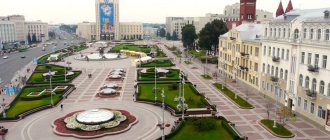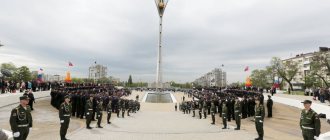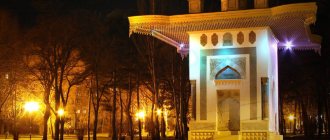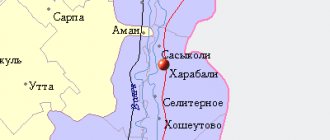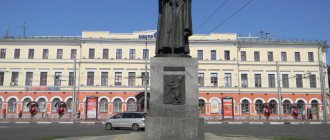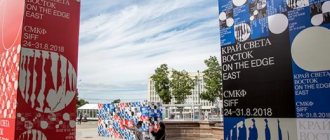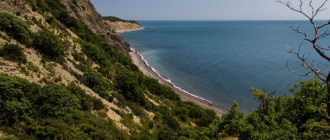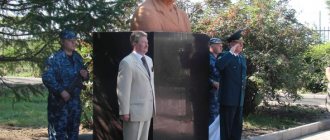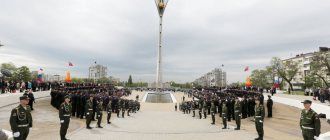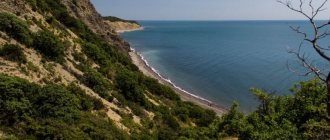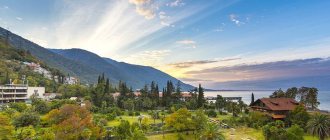The main city of Crimea, Simferopol, is often perceived by tourists only as a transit point on the way to the beautiful Crimean seaside resorts, but if you look closely at the city, you can find interesting and unique places. The main attractions of Simferopol are located in the center; exploring them can be combined with a walk around the city.
A few facts about Simferopol
- The city of Simferopol is the capital of Crimea, located in the center of the Crimean peninsula.
- The city is divided into two equal parts by the longest river of Crimea - Salgir.
- Simferopol was founded in 1784.
- In Simferopol there are many museums, ancient temples and parks, an academic theater, monuments of Soviet architecture, as well as the ruins of the ancient Scythian kingdom - Scythian Naples.
- The city is the air gateway to Crimea; Simferopol International Airport is located here.
- Simferopol was occupied from November 1, 1941 to April 13, 1944. The largest concentration camps in Crimea were located here: “Red” and “Potato Town”. There were underground resistance groups operating in the city.
- The Simferopol Reservoir was built near Simferopol in 1954.
- In the center of the city, historical buildings with interesting, notable buildings have been preserved: in the area of Pushkin, Karl Marx, Gogol, Gorky streets and Kirov Avenue.
- The population of Simferopol is 336 thousand people.
- The distance from Simferopol to ancient Bakhchisarai is 30 km, to Sevastopol - 83 km, to Yalta - 86 km, to Kerch - 218 km.
The most interesting places in the vicinity of Simferopol
The outskirts of Simferopol - Simferopol district - are literally overflowing with various attractions unique to Crimea. Stunningly beautiful caves, unique reservoirs, and picturesque waterfalls await you here.
Simferopol reservoir
- GPS coordinates: 44.922849, 34.154818.
An artificially created reservoir. It amazes with its size. Created in 1955 by creating a bulk dam on the Salgir River. At the bottom of the reservoir are the foundations of flooded houses and petrified trees.
Local residents have picnics and fish on the coast. However, boating is not allowed here. Swimming is also prohibited. Carp, perch, pike and bream are well fished from the shore. Good winter fishing. There are individuals weighing 2-3 kilograms.
Marble Cave
- Address: Mramornoe village, Simferopol district.
Located at the foot of Mount Chatyr-Dag. The entrance is located at an altitude of 918 m above sea level. Created by eroding limestone rocks with groundwater. Opened in 1987. Has three tiers. The length is two kilometers.
Now paths have been laid in the cave and fences have been installed. Travelers can admire fabulous figures: openwork baths, powerful stalactites, stone pillars, and strange growths on the rocks. Well-organized lighting enhances the effect. This is one of the most beautiful underground labyrinths in the world.
Kizil-Koba Cave
- Address: Simferopol district, Dobrovskoye rural settlement.
Red cave. Age - more than 2.5 million years. Length - 27 km. Area - 65,000 m2. Consists of six levels. It is the largest in Europe. The cave enchants with its incredible grottoes and halls.
There are underground lakes, picturesque waterfalls, sinter formations, stalactites and stalagmites. The main attraction is an 8-meter stalactite. Tourists are allowed to a depth of 500 meters. Paid entrance. Excursions with children are possible.
Stone mushrooms in Ivanova Balka
- Coordinates on the map: 44.891035, 34.318984.
An unusual natural phenomenon. A stone in the shape of a huge mushroom four meters high. Experts say that this is a fragment of a rock ridge. Ivanova Balka's business card. An object of curiosity for many tourists.
Su-Uchkhan Subotkhan Waterfall
- GPS coordinates: 44.869633, 34.343962.
The source of strength and youth in Crimea. The best time to visit this natural attraction of Simferopol is April and May. At this time, the river is full and the waterfall looks most impressive. Su-Uchkhan is considered a place of power. It welcomes pilgrims and nature lovers all year round. Shrouded in rumors and legends. To find the waterfall, it is better to use the services of a guide.
Also get to know the sights of Yalta, Feodosia, Kerch and Sevastopol.
The beautiful city is the capital of the resort region and is extremely attractive to tourists. All the necessary infrastructure is available here, and the various attractions of Simferopol will satisfy the discerning taste of the most spoiled traveler.
Simferopol station
Address: Simferopol, Station Square, 1.
The railway station building in Simferopol in the Stalinist Empire style is its decoration and the calling card of the city. It was built in 1951 according to the design of the architect A.N. Dushkin on the site of the old one, destroyed during the war. The station in Sochi was built according to the same project in 1952.
Simferopol station consists of three parts: the main building, the service building and the water tower with a clock 42 meters high, on the spire of which there is a red five-pointed star. The clock is the main mystery of the station, which numerous enthusiasts are trying to solve. On the dial of the watch, next to the numbers, there are signs of the zodiac, but their order is disrupted, and some signs are completely replaced by the constellations Ophiuchus, Canes Venatici and Cygnus. The parts of the station are interconnected by graceful arches and galleries. The main building of the station has a courtyard with a fountain with doves.
Memorial plaque to the underground sabotage group of railway workers
During the occupation of the city, an underground sabotage group of railway workers under the leadership of V.K. operated at the Simferopol station. Efremova, blowing up enemy trains. In total, the group committed 22 major acts of sabotage. In memory of the underground workers, in 1972 a bronze memorial plate with bas-relief portraits and names of those who died in March 1944 was installed on the station building.
Architecture of Simferopol
Wedding House
Architectural sights of Simferopol can be discovered while walking along the central streets of the city such as the pedestrian Karl Marx (formerly Ekaterininskaya), Pushkin, Gorky. The most striking historical buildings: the Academic Theater named after M. Gorky, the Taurida Museum, the House of the Noble Assembly (1848), the former mansion of Franz Schneider, now the Wedding House, the Shevchenko Cinema and others.
Art Museum
Website: simhm.ru Address: Simferopol, Dolgorukovskaya st., 35A.
The Simferopol Art Museum was opened as an art gallery of the Central Museum of Taurida in 1937. It is located in the building of the former officers' meeting of the 51st Lithuanian Infantry Regiment, built in 1913. In 1941, during the evacuation to Kerch, the exhibition of the Simferopol Museum was destroyed by the bombing of German planes. The building was heavily damaged during the German retreat from the city in 1944.
The gallery was reopened in 1947 with a new collection. The best paintings of the museum: “Still Life” by Petrov-Vodkin, “Night on the Dnieper” by Kuindzhi, “Evening at the Sea” by Aivazovsky, “Young Forest in Mary-Hovi” by Shishkin and others.
Central Museum of Tavrida
Website: tavrida-museum.ru Address: Simferopol, st. Gogol, 14.
The Central Museum of Taurida is a place where you can get acquainted with the nature and history of Crimea, starting from ancient times. Separate exhibitions are devoted to various aspects of life during the Tauride province and during the Great Patriotic War. The museum's collection includes more than 100 thousand exhibits
This attraction of Simferopol has a collection of numismatics, as well as a unique collection of graphics from the 18th – 19th centuries with views of the Crimea. A capacious photo and documentary fund tells in detail about the past of the peninsula. The museum holds its exhibitions not only in Crimea, but also beyond its borders. The museum participated in international exhibitions in Italy, France, and Germany.
Chocolate Museum "Salon du chocolat"
Both children and adults will be delighted by the local Chocolate Museum. At the Salon Du Chocolat cafe you can taste an incredible number of delicious desserts, cakes and pastries. A pleasant bonus will be the museum exhibition, which is located on the ground floor. The exhibits were created from absolutely all types of chocolate known in the world. More than a ton of sweet treats went into the figures.
In the chocolate museum you can see a tree with small figures of Indians, portraits of famous confectioners, Monomakh's hat, a village hut and even the Eiffel Tower, in the construction of which mathematicians took part in order to accurately measure all the proportions.
At the end, a souvenir awaits those with a sweet tooth - a chocolate ticket as a souvenir.
Crimean Academic Theater named after M. Gorky
Address: Simferopol, st. Pushkina, house 15.
Sights of Simferopol include cultural sites, such as the Crimean Academic Russian Drama Theater named after M. Gorky. The interesting architecture of the building attracts the attention of many tourists. The theater is located on the main street of the city. A. S. Pushkin.
The history of the oldest theater in Crimea began in 1820. Archival data suggests that the Moscow merchant Volkov, being a keen theatergoer, decided to establish a stage in a stone barn at the house of the noble assembly. Its modest appearance did not prevent the theater from becoming the center of cultural life in Crimea. The original name was the Simferopol Noble Theater.
Forty years later, a separate theater building was built; its hall accommodated 410 seats; it has not been preserved. The modern building, designed by architect A. N. Beketov, was built in 1911 in the neoclassical style with Art Nouveau elements. The main façade of the theater is decorated with sculptures and busts.
During the occupation of Simferopol, the underground group “Falcon” operated in the theater that continued to operate. Its director was the chief artist of the theater, Nikolai Baryshev. A month before the liberation of Simferopol, the Sokol group was discovered, and its members were captured and sent to the Krasny concentration camp. On April 10, they were shot in the Dubki tract, Simferopol region, and on April 13, the city was liberated.
In memory of the underground workers, a memorial plaque was installed on the theater building with the names of the actors and theater workers who were part of the Sokol group. The play “They Were Actors” based on the play by V. Orlov and G. Nathanson, which premiered at the theater in 1973, is also dedicated to their memory. The play was also released into a film of the same name at the Mosfilm studio in 1981.
Children's park
The greatest delight among young tourists is the Children's Park, on Kirova Avenue. The attractions are designed for both children and teenagers. Its highlight is the glade of Fairy Tales, where sculptors recreated the heroes of A.S. Pushkin’s story “Ruslan and Lyudmila”. There is also a zoo and an aquarium here.
You can end your visit to Simferopol with a walk through the evening city. You can taste local cuisine in one of the many cozy cafes and be sure to take a photo with a 5-trunk chestnut tree 25 meters high. It was planted in the city center by Fyodor Milhausen in 1829.
Shevchenko Cinema
Address: Simferopol, st. Gorky, 5.
The cinema building was built in 1904 by entrepreneur Leonid Sukhomlinov. In 1915, Yalta architect N.P. Krasnov added an arch decorated with stucco molding to it. In the Soviet years, the cinema was called “Star of the Revolution”, later “Bolshevik”, and under the Germans “Pallas”. In 1954, the cinema was named after Taras Grigorievich Shevchenko. The cinema has been showing films for more than a century; its purpose has never changed.
Gagarinsky Park
Today the park is in the process of reconstruction. Since the 60s of the last century, it has been the largest city park in Crimea. For several decades, the park has been a popular place for leisure and various city events. Evenly planted trees create welcome coolness in summer. Not far from the entrance from Tolstoy Street there are two small lakes equipped with catamarans. The ponds are a favorite place for a flock of ducks and several swans. The main attraction of the park is the Walk of Fame, leading to the Eternal Flame memorial.
Alexander Nevsky Cathedral
Address: Simferopol, st. Alexandra Nevsky, 6.
Gilded majestic domes rise in the very center of Simferopol and attract the eye. The history of the temple was not easy. The construction of the cathedral was proposed by Catherine II, but the idea was realized only under Nicholas I. The building was created according to the design of I. I. Charlemagne in collaboration with I. F. Kolodin. During Soviet times, the cathedral was looted and blown up in 1930.
The restoration of the temple has been discussed since the 90s of the last century, but real steps towards its restoration began in 2003. By 2019, all premises have already been built. Services are held regularly in the lower part of the temple.
Alexander Nevsky Cathedral
The majestic Alexander Nevsky Cathedral with golden domes was destroyed in 19.30 and its reconstruction is still underway. After all the work is completed, this will undoubtedly be one of the most beautiful places in Crimea.
Next to the cathedral there is Victory Park, where you can hide from the heat in summer or enjoy the beauty of golden autumn.
Peter and Paul Cathedral
Address: Simferopol, Petropavlovskaya square, 1.
The exterior of the cathedral elegantly combines classics and elements of Old Russian patterns. The stone building in the shape of a cross is crowned by a drum with 12 windows and a large onion-shaped dome, which is clearly visible from the city center. The cathedral was erected in the mid-19th century on the site of a dilapidated wooden church. Funds for construction were collected by the people and not without the help of the Holy Synod. The opening of the cathedral took place in 1870. With the advent of Soviet power, the temple, like many others, was closed and turned into a warehouse. Restoration began in the eighties of the 20th century.
What to see in Simferopol in 1 day
The city, with its inherent southern charm, fresh air and shady alleys, is rightfully considered the pearl of Crimea. Local residents respect the history of their native land, preserving its main attractions. When visiting Simferopol for a short visit or spending a vacation here, you should definitely visit the most famous places.
Naples Scythian
The first evidence of the location of the ancient settlement was found in 1827. Almost a hundred years later, excavations resumed and continue to this day. On the territory of the archaeological complex there is a security pavilion and ruins of urban buildings. Much of the Scythian settlement remains hidden underground.
Address: Arkhaeologicheskaya street, 1.
Opening hours: Tue.-Sun. 9:00-17:00.
How to get there: bus 85, minibus 4 goes to the “Napol Scythian” stop.
Get directions
Simferopol kenassa
The religious building was erected in the 19th century at the expense of the Karaite community inhabiting the peninsula. The unusual architecture of the building in the Byzantine style with Gothic elements makes the kenassa one of the main attractions of the city.
Address: Karaimskaya street, 6.
Opening hours: Sat. 10:00-12:00.
How to get there: at the stop “Ul. Sergeev-Tsensky" buses 70, 49A, minibuses 54, 63, 79, 83, 99 stop
Get directions
Peter and Paul Cathedral
The cathedral was built in the second half of the 19th century on the site of a dilapidated Orthodox church. During Soviet times, the bell tower and dome of the temple were demolished. Only in the 80s, according to the surviving drawings, the cathedral was restored and returned to the church.
Address: Proletarskaya street, 7.
Opening hours: Mon.-Sat. 7:00-17:30, Sun. 6:30-17:30.
How to get there: buses 4, 54, 78 pass through the Oktyabrskaya Street stop.
Get directions
Kebir-Jami Mosque
The historical sights of Simferopol are represented by the Kebir-Jami Mosque. Built in 1508, the building changed its appearance several times. Today, the functioning mosque combines the functions of the center of the Muslim community.
Address: Kurchatova street, 4.
Opening hours: daily 7:00-20:00.
How to get there: buses 4, 54, 78 go to the Oktyabrskaya Street stop.
Get directions
Alexander Nevsky Cathedral
The idea of building the cathedral belonged to Catherine II, but work began after her death. During Soviet times, the Bolsheviks blew up the temple. The building of the modern cathedral was built in 2009. A visit to the temple with its gilded domes, bell tower and triangular pediment is included in most tourist routes around the city.
Address: Alexander Nevsky street, 6.
Opening hours: daily 8:00-18:00.
How to get there: buses 49, 62, 12B, minibuses 25, 59, 60, trolleybuses 5, 9, 11 come to the “Glavpochtamt” stop.
Get directions
Vorontsov's house
The classic Russian estate was built for Governor Naryshkin in the first half of the 19th century. Later, Prince Vorontsov bought the house. Under him, a park appeared around the estate, which today is supervised by the National Institute. Vernadsky.
Address: Vernadsky Avenue, 2.
Opening hours: daily 8:00-16:00.
How to get there: trolleybuses 4, 14, bus 49, minibuses 27, 54, 63, 85, 118 go to the “Moscow Hotel” stop.
Get directions
Bogatyr of Taurida
The main natural attraction of the city, called the hero of Taurida, grows in a children's park. The tree, 30 meters high, is over 750 years old, according to experts. They say that this oak inspired Pushkin to write the poem “There is a green oak at Lukomorye.”
Address: Kirova Avenue, 51.
How to get there: buses 12B, 49, 63 and minibuses 15, 41, 60, 88, 96 stop at the Kuibysheva Square stop.
Get directions
Holy Trinity Convent
The cathedral was built in the second half of the 19th century; since 2002 it has served as a women's monastery. Tourists are interested in the architecture of the monastery with Corinthian capitals, a bell tower, and blue domes. The main shrine of the church is the relics of St. Luke.
Address: Odesskaya street, 12.
Opening hours: daily 7:00-17:30.
How to get there: buses 4, 54, 78 go through the Oktyabrskaya Street stop.
Get directions
Concentration camp of the state farm "Red"
During the German occupation, the largest concentration camp on the Crimean Peninsula was located here. 15 thousand people died on its territory. In order to perpetuate their memory, a memorial complex was created, including an obelisk, a mass grave, and an Orthodox church.
Address: Mirnoye village, Belova street, 44.
Opening hours: Wed.-Mon. 10:00-17:00.
How to get there: from the Zapadnaya bus station to the final stop, bus 89 goes.
Get directions
Trinity Monastery
Address: Simferopol, Odesskaya st., 12.
The temple has classical architectural forms. In the middle rises a dome decorated with an openwork cross, standing on an octagonal light drum. A low bell tower was erected next to the temple. The facade of the temple is decorated with decorative patterns and mosaic images.
Before the construction of the stone building, there was a small wooden church in its place, founded in the 90s of the 18th century. The temple was converted in 1868. The renovated stone temple with a bell tower has stood without destruction to this day.
The temple houses two shrines: the icon of the Mother of God “Sorrowful” and the relics of St. Luke. The outstanding surgeon was a minister of the church from 1946 to 1961, known as Archbishop Luke (Voino-Yasenetsky).
Where to go for tourists in Simferopol interesting places
There is something to see in Simferopol for tourists who want to diversify their program by visiting natural attractions, cinemas, shops and other popular places among city residents. Travelers vacationing with children should definitely visit the safari, ostrich farm and children's park.
Cinema park "Viking"
A popular tourist spot arose after the completion of filming of the film “Viking”. The complex recreates the Viking settlement that inhabited these places in the 8th-11th centuries. On the territory of the cinema park there are cafes, souvenir shops, a blacksmith shop, and master classes and theatrical performances are held.
Address: Perevalnoye village, Stadionnaya street, 15.
Opening hours: daily in summer 9:00-22:00, in winter Sat-Sun. 9:00-18:00.
How to get there: from the bus station by regular bus to the “Red Caves” stop.
Get directions
Cinema named after T. G. Shevchenko
The cinema, founded at the beginning of the 20th century, attracts with its unusual architecture in the Art Nouveau style. Initially, there was one hall inside, designed for 800 seats. After a large-scale reconstruction, the cinema opened 5 halls, equipped in accordance with modern requirements for comfort and safety.
Address: Gorky street, 5.
Opening hours: buses 3, 7, 22, 50, 98, trolleybuses 4, 9, 15, minibuses 2, 15, 48, 112 go to the Lenin Square stop.
How to get there: daily 9:00-22:30.
Get directions
Children's park
The city's central park was founded in 1958. Previously, in its place there was a Palace of Pioneers, a swimming pool, and a living corner. After reconstruction, attractions, a petting zoo, an aquarium, and a roller skating rink appeared here. What the park is famous among townspeople is its children's astronomical observatory.
Address: Kirova Avenue, 51.
Opening hours: daily 7:00-20:00.
How to get there: buses 3, 12B, 29, 55, 70, trolleybuses 4, 15, minibuses 1, 10, 41 run through the Kuibysheva Square stop.
Get directions
Safari Park "Taigan"
The park is divided into several zones, the largest being reserved for safari. Visitors are invited to watch the predators from fenced bridges or approach them by car. The complex also has an aviary, a touching and classic zoo.
Address: Belogorsk, Lavandovaya street, 1.
Opening hours: in summer 8:00-20:00, in winter 8:00-16:00.
How to get there: by regular bus or transfer from Simferopol airport.
Get directions
Park named after Yu. Gagarin
A city park with an area of 50 hectares was laid out in 1960. This is a favorite place for city residents, where guests of the Crimean capital will also be interested in going. In the park there are walking alleys, cafes, lakes where you can ride a boat or catamaran, enjoying the silence and solitude.
Address: Gagarin street.
Opening hours: 24/7.
How to get there: buses 12B, 27, 64, 85, trolleybuses 6, 14 arrive at the Gagarinsky Park stop.
Get directions
State Academic Musical Theater of the Republic of Crimea
The theater center is based on the Kyiv mobile theater. In 1977, a spacious building was built for it, where musicals, symphony concerts, ballets, and opera performances take place. The musical theater combines the functions of the city's main concert venue, hosting touring artists.
Address: Kirova Avenue, 17.
Opening hours: daily 9:00-19:00.
How to get there: buses 3, 7, 22, 50, 98, trolleybuses 4, 9, 15, minibuses 2, 15, 48, 112 go to the Lenin Square stop.
Get directions
City History Museum
The museum was founded in 2009 on the initiative of local authorities. Its exposition was formed with the active assistance of the townspeople. Among the exhibits are historical documents, photographs, and household items. The museum building itself is located in a historical place in Simferopol, where many outstanding personalities of their time lived.
Address: Pushkin street, 17.
Opening hours: Tue.-Sun. 10:00-17:00.
How to get there: buses 3, 7, 22, 50, 98, trolleybuses 4, 9, 15, minibuses 2, 15, 48, 112 run through the Lenin Square stop.
Get directions
Art Museum of Simferopol
The gallery was founded at the beginning of the last century. The main collection of the exhibition consists of art objects, sculptures, works of famous Russian, Eastern, and Western European artists. The gallery holds temporary exhibitions every year.
Address: Dolgorukova street, 35A.
Opening hours: Tue. 12:00-20:00, Wed-Sun. 10:00-17:00.
How to get there: buses 12B, 50, 98, minibuses 57, 60, 81, 91, 112 arrive at the Art Museum stop.
Get directions
Chocolate Museum
The interesting places of the Crimean capital are complemented by the Chocolate Museum. It took more than a ton of delicacy to create an exhibition of different types of chocolate. During the tour, visitors can learn a lot of interesting facts and information about the preparation of this dessert.
Address: Kirova street, 66.
Opening hours: daily 10:00-18:00.
How to get there: buses 3, 12B, 29, 55, 70, trolleybuses 4, 15, minibuses 1, 10, 41 run to the Kuibysheva Square stop.
Get directions
Crimean Ethnographic Museum
The city's ethnographic museum is a place worth visiting to get an idea of the culture, history and traditions of the peoples inhabiting Crimea. His collection consists of paintings, national costumes, and household items. The exhibition center conducts educational activities, organizes festivals and folk art exhibitions.
Address: Pushkin street, 18.
Opening hours: Mon., Wed., Fri.-Sun. 9:00-18:00, Thu. 11:00-20:00.
How to get there: to the stop “Park im. Trenev" trolleybuses 4, 7, 15, buses 3, 12B, 30, 63, 98, minibuses 2, 15, 48, 112 arrive.
Get directions
Museum of Electric Transport
The museum was opened in 1977 by the local trolleybus authority. To date, the exhibition collection includes 3,000 exhibits. Visitors are invited to familiarize themselves with the history of the formation and changes that have occurred in the electric transport industry.
Address: Kyiv street, 78.
Opening hours: Mon.-Thurs. 8:00-14:00, Fri. 8:00-13:00.
How to get there: buses 12A, 55, 62 and minibuses 14, 27, 64 go to the Trolleybus Park stop.
Get directions
Crimean Academic Puppet Theater
The theater was founded on the basis of a mobile youth theater in 1939. Its repertoire mainly consists of children's performances, but there is also something for an adult audience to watch. The productions “The Hound of the Baskervilles”, “Kashtanka”, and “Jazz Fantasy” are especially loved by the public.
Address: Gorky street, 9.
Opening hours: Tue.-Sun. 10:00-16:00.
How to get there: buses 12A, 98, minibuses 25, 57, 60, 91, 112 run through the “Center” stop.
Get directions
Russian Drama Theater named after. M. Gorky
The theater, founded in the second half of the 19th century, is one of the oldest in Russia. His repertoire consists of classical and modern productions in the following genres: comedy, drama, tragedy. The theater has its own studio that trains young artists.
Address: Pushkin street, 15.
Opening hours: daily 10:00-19:00.
How to get there: to the stop “Park im. Trenev" trolleybuses 4, 7, 15, buses 3, 12B, 30, 63, 98, minibuses 2, 15, 48, 112 arrive.
Get directions
Archaeological Museum
The museum's collection displays historical artifacts found during archaeological excavations on the peninsula. The exhibits include stone tools, ceramics, jewelry, and sculptures. The excursion route passes not only through the exhibition halls, but also includes visits to memorable places in Simferopol.
Address: Gavena street, 101.
Opening hours: Mon.-Fri. 10:00-18:00.
How to get there: buses 7, 98, trolleybuses 4, 9, minibuses 2, 54, 99 pass through the Zalesskaya Street stop.
Get directions
Kebir-Jami Mosque
Address: Simferopol, st. Kurchatova, house 4.
The Kebir-Jami Mosque is made in a restrained style, straight lines without additional decorations. The exterior is complemented by a balcony and tiled roof. The only low minaret is crowned with a cone with a crescent. Like many years ago, the building was painted with white lime; according to legend, it was thanks to this that Simferopol received its first name - Ak-Mosque (which means white mosque).
Kebir-Jami is the oldest mosque in Simferopol, located within walking distance from the center. The Muslim shrine was erected at the beginning of the 16th century. The mosque was reconstructed more than once, and since 1945, it has been empty for a long time. The new life of the mosque began at the end of the 20th century after the return of the Crimean Tatars.
Karaite kenassa
Address: Simferopol, Karaimskaya st., 6.
Sights of Simferopol include religious shrines of Karaites, Muslims and Christians. In the central part of Simferopol you can find an interesting architectural structure - the Karaite kenassa, which combines Byzantine, Moorish and Gothic motifs. The Karaites are a small Turkic people who profess a religion in many ways similar to Judaism. By the end of the 19th century, the Karaite community had grown significantly, so a larger building was needed to hold services. The religious building with intricate architectural patterns was built between 1881 and 1896. with money from donations.
After the arrival of the Bolsheviks, the kenassa suffered the fate of most religious buildings: the building was closed, and on the facade the six-pointed Star of David was changed to a five-pointed one. After the war, the building was not used for religious purposes. The full return of the Simferopol kenassa to the Karaites was made only in 2014. Since 2016, the building has been undergoing restoration.
Salgirka Park
Address: Simferopol, prosp. Academician Vernadsky, 2.
Salgirka Park is an ancient, largest park in Simferopol, also called Vorontsovka or Botanical Garden. The park is located on the banks of the Salgir River near the Simferopol Reservoir. The history of the park begins at the beginning of the 19th century, when the famous German scientist P.S. Pallas, who served in the Russian Empire at that time, planted the first plants. The two-hundred-year-old plane tree in the center of the park reminds of the hand of the great scientist.
The park received new life in 2003, when it was decided to establish a botanical garden on the basis of the Salgirka monument park. The park has several zones. The most popular and colorful part is the rose garden, which has about 200 varieties of roses. The territory also includes a syringarium (lilac garden) and an iridarium (iris garden). In the park you can stroll along the alley made of Lebanese cedar and sakura. Closer to the southern exit there is a cascade of ponds with semi-aquatic vegetation.
House of Prince Vorontsov
Address: Simferopol, Vernadsky Ave., 2.
There is another attraction on the territory of the botanical garden - Vorontsov’s house. The mansion in the classical style was erected in the 19th century for the governor of Tavrida D. M. Naryshkin. The next owner was M.S. Vorontsov. Nobles often stayed in the mansion; even the family of Nicholas I visited this estate.
The exterior decoration of the house is made in a strict classical style. The façade, from which a staircase decorated with figures of marble lions runs, is complemented by columns. Vorontsov's house was restored several times; today the park displays an accurate reconstruction of the original building.
Beautiful places in Simferopol that are worth visiting
There is something to visit in Simferopol for tourists who want to get acquainted with the history, customs and traditions of the peninsula. The cultural life of the capital of Crimea is diverse and exciting. Places worth visiting include the musical theatre, archaeological and art museums.
Simferopol reservoir
The largest reservoir in Crimea was built to provide the city and surrounding areas with fresh water. Its water reserves are replenished by the Salgir River. The area around the reservoir is protected, but during the season you are allowed to fish, have picnics, and walk around enjoying the natural beauty.
Address: Yalta highway E105.
How to get there: trolleybuses 4, 21, 52, 55, bus 49, minibus 41, 60, 64, 114 pass through the “Student City” stop.
Get directions
Catherine's Garden
The garden, with elements typical of the English style, was laid out in the 19th century. The central part of the park is decorated with a monument to Catherine the Great. During Soviet times, the previous monument was destroyed. The modern monument was erected in 2016. The garden is divided into zones for active and relaxing recreation.
Address: Lenin street, 1.
How to get there: buses 3, 7, 30, 22, 70 arrive at the Sovetskaya Ploshchad stop.
Get directions
Denisovskaya ostrich farm
The ostrich farm is a place where tourists with children will be interested to visit. Ostriches, horses, sheep, and quails are bred on a vast territory. Visitors are invited to play paintball, walk along the river, ride horses, visit the rope park and zoo, and purchase eco-products.
Address: Denisovka village, Solnechnaya street, 57.
Opening hours: daily 9:00-18:00.
How to get there: by bus from the stop “Ul. Borodin" to the farm.
Get directions
Naples Scythian
Website: neapolis-scythian.com Address: Simferopol, st. Archaeological, 1. Opening hours: from 10.00 to 18.00, closed on Monday. Ticket price: 100 rubles, children under 16 years old - free.
On the outskirts of Simferopol, on Petrovsky Heights, there is one of the oldest attractions of Simferopol - Scythian Naples. This is the largest barbarian fortress in the Northern Black Sea region; its history spans the 2nd century. BC. – III century AD The heyday of Scythian Naples was in the 2nd century BC, when the capital and residence of King Skilur was located here.
At the beginning of the 19th century, the local population actively dismantled the ancient ruins into stones for construction. The study of Scythian Naples began in 1827, after the accidental discovery of a slab with a relief image of a horseman and marble pedestals with Greek inscriptions. Many famous scientists have contributed to the study of Scythian Naples. In 2011, the settlement was given the status of the Scythian Naples Museum-Reserve.
On a high hill with rocky slopes you can see the remains of defensive walls, the foundations of ancient buildings, and the royal mausoleum. It also offers a panoramic view of Simferopol.
TOP 6 attractions of Simferopol for one day
Every city has historical and architectural monuments that are considered its calling cards. The attractions of Simferopol described in this part of the article fall into this category.
Dolgorukovsky spire
- Address: st. Zhukovsky. Transport stop "Center".
One of the main symbols of the capital of Crimea is the monument, inaugurated in 1842 in honor of the victory of the army under the command of Prince Vasily Dolgoruky over the army of the Crimean Khan in 1771, after which the peninsula became part of the Russian Empire. The monument has the shape of a classic Egyptian obelisk and is 20 m high.
The pillar, made of diorite blocks, rises above a two-level pedestal. On the sides of the pedestal there are marble slabs with bas-reliefs depicting the heraldic symbols of Russia and the house of Dolgorukov, the prince himself, crowned with a laurel wreath, moments of battles.
Scythian Naples
- Opening hours: daily, except Mondays, from 10:00 to 18:00.
- Ticket price: adult 70 rubles, children 20 rubles.
- Telephone
- Website: https://www.neapolis-scythian.ru
- Address: st. Archaeological, 1. Transport stop “Ulitsa Tarabukina”.
The open-air archaeological museum is rightfully one of the iconic attractions of Simferopol. The ruins of the capital of the Scythian state, which existed since the 3rd century. BC e. and has long competed with Chersonesus, is visited annually by thousands of tourists.
Excavations on an area of about 20 hectares are still ongoing. During the excursion you can examine fragments of the fortress wall, the skeletons of various buildings, the reconstruction of the mausoleum of King Skilur, during the study of which many valuable artifacts were discovered.
Karaite kenassa
- Address: st. Karaimskaya, 6. Transport stop “Ulitsa Kavkazskaya”.
The Karaite prayer house is rightfully considered the main architectural landmark of Simferopol. The amazing building was erected in 1896 with funds from a community of Jews professing a special branch of Judaism. Its exterior intricately intertwines the features of lush Byzantine, romantic Moorish and solemn Gothic style.
Kenassa looks like a small feudal castle and a palace at the same time. During the years of persecution of religion, the building was partially rebuilt and was used for a long time by various government agencies, and it was returned to the Karaite community in 2014. Two years later, the restoration of the kenassa began, which continues to this day.
Kebir-Jami Mosque
- Address: st. Kurchatova, 4. Transport stop "Oktyabrskaya Street".
The Muslim temple, erected in 1508 at the behest of Khan Mengli-Gerey, is the oldest building in Simferopol, included in the register of architectural monuments of federal significance. The mosque acquired its current exterior during reconstruction carried out at the beginning of the last century.
It was then that the dome covering the main volume was replaced by a hexagonal drum and a pitched roof. With its shape, the elegant structure, built from shell rock, is very reminiscent of an ancient basilica. After the end of the Second World War, the mosque was closed, and a bookbinding workshop was located within its walls for a long time. Today the temple is run by the Muslim community.
Train Station
- Address: Station Square, 1. Transport stop "Railway Station".
The building of the railway station cannot but arouse admiration. At first glance, it is easy to mistake it for a luxurious palace in the style of a Florentine or Venetian palazzo. Moorish galleries, the vaults of which are supported by graceful columns with luxurious capitals, a massive arched passage and a quadrangular 42-meter clock tower, form a delightful architectural ensemble.
The tower is crowned by a three-level rotunda with a high spire, designed in the style of a basilica. Four dials with a diameter of about 3 meters, in addition to digital markers, are decorated with images of zodiac signs. The building, erected in 1951, looks beautiful after restoration.
New terminal of Simferopol airport
- Address: Reunion Square, 1.
Launched in 2022. It took two years to build. Cost the city 32 billion rubles. It is considered the most modern and stylish in Russia. Outwardly it looks like a huge wave. The floor is reminiscent of the reliefs of Crimea. One wall is decorated with a composition of live and artificial plants.
On the other there is a map of the peninsula made of colored moss. A hotel and conference hall will be built next to the terminal. A park with an artificial lake will be built nearby. This is a very beautiful place with a European level of service.
Memorial "Concentration Camp Red"
Website: memorialkrasniy.ru Address: Simferopol district, Mirnoye village, Belova street, 44.
The memorial to the victims of the fascist occupation of Crimea of 1941-1944 “Krasny” concentration camp was opened on May 8, 2015 - on the eve of the 70th anniversary of the Victory. It is located on the site of the German concentration camp "Red" - the largest death camp in Crimea, in which more than 15 thousand Soviet citizens died. At first there were captured Red Army soldiers here, and from July 1942 - the defenders of Sevastopol. Later, partisans, underground fighters, members of their families, including children and those who helped the resistance or were suspected of doing so, were sent here. Most of the names of the victims of Nazism have not yet been identified.
The concentration camp was built in November 1941 on the site of the Krasny state farm. It consisted of three barracks, surrounded by two rows of barbed wire; two housed men, the third housed women and children. There were about 2 thousand people in the camp at the same time. Mass executions took place near the camp - in the Dubki tract. On April 10, 1944, actors and workers of the Simferopol Drama Theater, members of the underground group “Falcon,” were shot here.
The museum building is built in the form of a black barracks; one of its walls is a wall of grief, on which the names of the victims are engraved. New names identified by search engines are added to the wall every year. At the entrance to the museum there is a bronze monument to the victims of the Krasny concentration camp, who are located at the bottom of the execution pit. The most poignant monument is a little bronze girl, stretching out her hands in horror with a plea for help. This is in memory of the children who died in the concentration camp.
Architectural delights and monuments in Simferopol
The city will simply enchant connoisseurs of elegant architecture and monumental art. Among the things you should definitely see in Simferopol, there are many colorful buildings and interesting monuments.
Vorontsov mansion
- Address: st. Yaltinskaya, 2. Transport stop "Moscow Hotel".
The mansion in the picturesque Vorontsovsky Park, built in 1827, is considered one of the iconic landmarks of Simferopol. The building is an excellent example of classicism in architecture. On the side of the main entrance, two symmetrical portals are separated from the main volume.
Between them is a terrace supported by four magnificent columns. It is reached by a staircase with an elegant parapet, guarded by two stone lions. Members of the imperial families and the autocrats themselves stayed in this small palace more than once.
Monument to Catherine the Great
- Address: Catherine's Garden. Transport stop "House of Cinema".
A monument in honor of Empress Catherine II, who ordered the founding of Simferopol, appeared in the city garden in 1890. After standing for 41 years, the sculpture of the autocrat was removed from the pedestal and destroyed by the Bolsheviks who came to power. Historical justice triumphed in 2016.
Then the bronze statue of Catherine the Great, holding the royal scepter and a map of Crimea in one hand, and with the other hand pointing to the place where the city should be founded, took its rightful place. At the feet of the queen there are sculptures of princes Potemkin and Dolgorukov, and on the sides of the pedestal there are busts of A. Suvorov and Y. Bulgakov.
Memorial "Concentration camp "Red"
- Address: Mirnoye village, Belova street.
Dedicated to the victims of the fascist occupation of Crimea in 1941-1944. During the Great Patriotic War, not far from Simferopol, on the site of the Krasny state farm, the enemies created a huge concentration camp. People were brought here from all over Russia. Gradually it became a gigantic conveyor belt of death, in which executions took place continuously.
70 years after the terrible events, a memorial complex was erected. In the center is a mass grave with an obelisk and three signs on the wells of death. Around the grave there is an area covered with gray granite chips. It symbolizes the burnt earth. To the side of the alley there is a strict temple-chapel and an eternal flame burns.
Cinema "Simferopol"
- Address: Kirova Avenue, 37. Transport stop “Dom Kino”.
The building of the Simferopol cinema, erected in 1936 and reconstructed 20 years later, is considered one of the architectural pearls of the city. Initially, it was built according to a standard project, similar to the Oktyabr cinemas in Smolensk and Rodina in Moscow .
However, it was not possible to complete the work by the beginning of the war. In addition, during one of the air raids, the structure was seriously damaged. When construction resumed, several changes were made to the project, thanks to which the building acquired an original exterior that is difficult to take your eyes off.
Monument to A.V. Suvorov
- Address: square named after. A. V. Suvorova. Transport stop "Glavpochtamt".
The greatest Russian commander did a lot to ensure that Crimea became part of the Russian Empire. On the site where there was once a military camp commanded by Alexander Vasilyevich, a small monument was erected in 1951.
After 34 years, it was replaced with a new composition. Above the low granite pedestal with a commemorative plaque, rises a bronze statue of the Count of Rymnik and the Prince of Italy. The Generalissimo, dressed in a field uniform, stands in a pose full of pride, resting his hand on the hilt of his saber. His look is full of courage and determination.
Square of the 200th anniversary of Simferopol
- Address: Sovetskaya Square. Transport stop "House of Cinema".
You should definitely visit the wonderful park with a fountain, which is rightly considered one of the city’s iconic attractions. Here you can not only take a walk and have a snack in one of the cafes, but also admire the unique collection of forged sculptures, regularly replenished since 2007 by Simferopol blacksmiths.
The creations of masters who create real masterpieces from metal are impressive. Every self-respecting tourist considers it a duty to take a photo against the backdrop of a knight’s sword, kittens climbing a fence, a steel globe or a motorcycle with angel wings.
Apartment house Krylov
- Address: st. Efremova, 18.
Built in 1894. The façade faces the Old Bazaar. The attraction is part of a complex of buildings that form the appearance of the market square. On the ground floor there are shopping pavilions. On the second floor there are living quarters.
The house is famous for its wooden gates - typical of the late 19th century and unique today. It is planned to restore them: return the lost parts, install pre-revolutionary fittings, and paint them in a suitable color. In short, to restore the façade to its former impressiveness and beauty.
